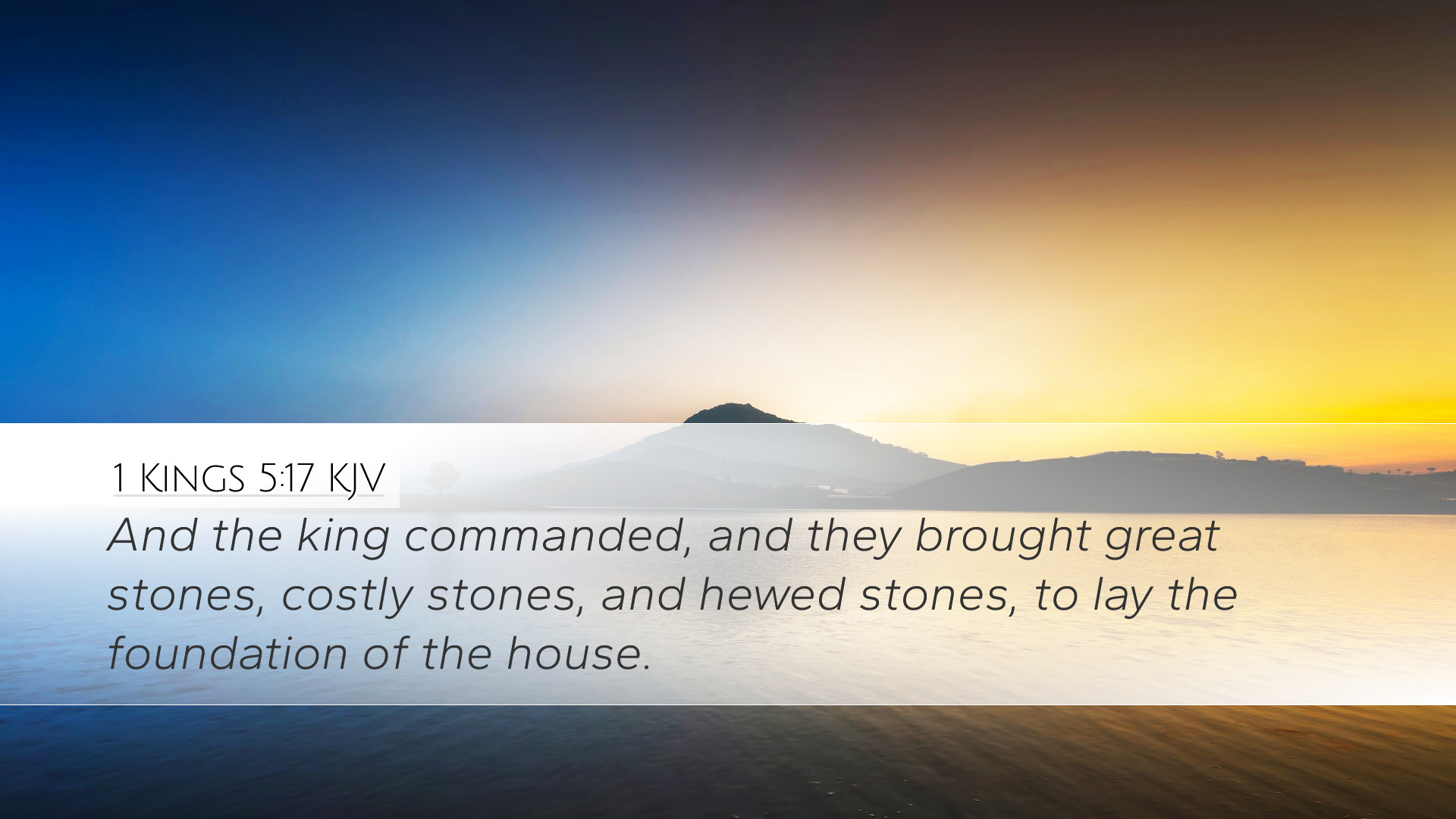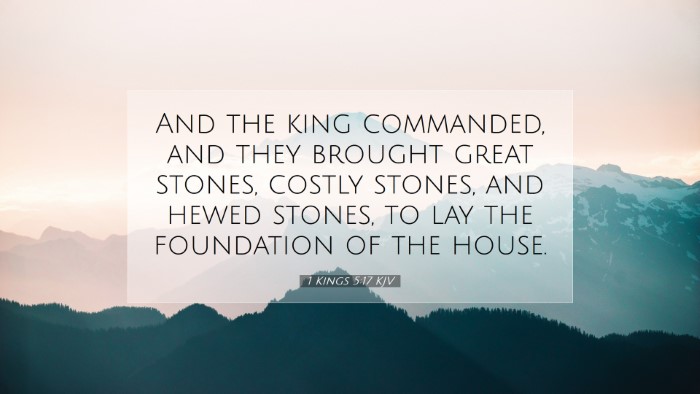Old Testament
Genesis Exodus Leviticus Numbers Deuteronomy Joshua Judges Ruth 1 Samuel 2 Samuel 1 Kings 2 Kings 1 Chronicles 2 Chronicles Ezra Nehemiah Esther Job Psalms Proverbs Ecclesiastes Song of Solomon Isaiah Jeremiah Lamentations Ezekiel Daniel Hosea Joel Amos Obadiah Jonah Micah Nahum Habakkuk Zephaniah Haggai Zechariah Malachi1 Kings 5:17
1 Kings 5:17 KJV
And the king commanded, and they brought great stones, costly stones, and hewed stones, to lay the foundation of the house.
1 Kings 5:17 Bible Commentary
Commentary on 1 Kings 5:17
1 Kings 5:17 states, “And the king commanded, and they brought great stones, costly stones, and hewed stones, to lay the foundation of the house.” This verse marks a significant moment in the preparations for the construction of Solomon's temple, reflecting both the grandeur and the seriousness of this sacred endeavor. The insights from various public domain commentaries illuminate the theological and practical implications of this moment.
Historical Context and Significance
In this passage, Solomon is preparing to build the temple, a task that reflects God's covenant with His people. The immense stones he commanded to be brought signify not only the physical strength needed for the construction but also the spiritual and communal commitment of the Israelites to their God. Commentators like Matthew Henry emphasize that the temple is more than a building; it is a symbol of God's dwelling among His people and a place for them to encounter Him.
Materials for the Temple
In this verse, the emphasis on "great stones" and "costly stones" highlights the importance of quality in the construction of a place dedicated to God. Albert Barnes notes that these stones, carefully hewn and selected, would ensure the temple's stability and beauty. The meticulous choice of materials is a metaphor for the care and reverence with which God’s people should approach their worship and service.
Theological Implications
- The Concept of Sacred Space: The idea that God requires not just any space, but a consecrated place for worship, is significant in biblical theology. Adam Clarke elaborates on this, reflecting that God deserves the best from His people, as represented by the costly stones.
- Divine Instruction and Human Response: This narrative illustrates the harmony between divine commands and human action. Solomon's obedience to God's directive is crucial. The verse encapsulates how God provides the vision (the temple) and expects His people to respond appropriately.
- Symbolic Foundations: The foundation of the temple symbolizes spiritual foundations—strong and enduring faith. The great stones can be seen as a foreshadowing of Christ, the cornerstone upon which faith is built, as expounded by many scholars.
Reflection on Leadership and Community Involvement
Solomon’s leadership is brought to light in this passage; he commands the gathering of resources and the labor for construction. This reflects a vital aspect of pastoral leadership today, where leaders must mobilize their communities for collective worship and mission. As Henry suggests, leaders must not only have a vision but also ensure that their community is aligned and participating in the work of the Lord.
The Role of the People
In building the temple, the congregation participates in a labor of love, contributing to something that surpasses their individual lives. The act of hewing stones is a communal effort that binds them in faith and purpose. Adam Clarke reminds us that this preparation was not merely a task for the king but involved the whole nation.
Practical Applications
- Excellence in Worship: Just as Solomon sought the best materials for the temple, Christians are called to offer their best in worship. This includes time, talent, and treasure.
- Collective Responsibility: Building a community of faith is a collective effort. Just as Solomon had support, modern church leaders must encourage involvement from all members in various aspects of God’s work.
- Preparation for God’s Presence: The verse challenges believers today to consider how they prepare their hearts and communities to meet with God. What ‘stones’ need to be hewn in their lives for deeper worship?
Conclusion
1 Kings 5:17 serves as a pivotal moment in the Israelite history, reflecting Solomon's commitment to God through the building of the temple. It challenges today’s leaders and congregants alike to reflect on the quality of their offerings to God, the importance of communal involvement in sacred tasks, and the need to establish strong foundations—both physically and spiritually. In this way, the verse continues to inspire and guide those who seek to honor God in their worship and communal life.


